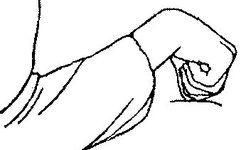Health and WellnessWishing you good health and happiness!
In daily life, discomfort in the shoulders and neck, as well as soreness in the waist and legs, is inevitable. When the condition is not severe, most people choose to have family members or themselves perform massage therapy. What are the commonly used tui na (推拿) massage techniques? How should these techniques be specifically performed?
Acupoint massage is a treasure of Chinese medicine, based on the theory of meridians and acupoints. By stimulating specific acupoints in the body, it activates the qi (气) of the meridians, achieving effects such as unblocking meridians, adjusting functions, and expelling pathogenic factors while supporting the body’s righteousness. This therapy includes various techniques such as pressing, rubbing, pushing, and grasping, which can relax muscles, relieve fatigue, and enhance the body’s immunity, as well as balance yin and yang. Regular acupoint massage is particularly suitable for middle-aged and elderly individuals, helping to strengthen the body and delay aging.
One-Finger Zen Technique
Relax the shoulders, drop the elbows, suspend the wrists, keep the palms light, and apply pressure with the fingertips (thumb). Use the forearm to swing and drive the flexion and extension of the thumb joint. The swinging amplitude should be uniform, at a rate of 120-160 times per minute, applying firm pressure while moving slowly along specific areas (acupoints) or meridians. The One-Finger Zen technique has a small contact area but great penetrating force, suitable for acupoints all over the body, commonly used on the head, neck, chest, abdomen, back, and limbs.
(1) Sitting posture
(2) Suspend the wrist, hold a loose fist, and apply pressure naturally with the thumb
(3) Wrist swinging outward
(4) Wrist swinging inward
Pushing Technique
Along specific areas (acupoints) or meridians, apply pressure with fingers, palms, or the ulnar side of the forearm, performing slow, unidirectional linear movements. This technique is divided into finger pushing, palm pushing, and forearm pushing. During operation, keep fingers, palms, and elbows in close contact with the treatment area, applying even force consistently, heavy but not stagnant, light but not floating, at a rate of 80-100 times per minute. The pushing technique is commonly used on the shoulder and back, chest and abdomen, and limbs.
Elbow Pushing Technique
Palmar Pushing Technique
Grasping Technique
Using the thumb and the index and middle fingers to pinch the acupoint or area, gradually applying pressure while performing continuous kneading motions, referred to as the three-finger grasping technique; adding the ring finger makes it a four-finger grasping technique; adding the little finger makes it a five-finger grasping technique, also known as the grabbing technique. Apply pressure with the finger pads, ensuring continuous kneading motions, with force increasing from light to heavy and then back to light. The key point is “lifting and pinching is grasping,” at a rate of 80-100 times per minute. The grasping technique is often combined with other techniques for the neck, shoulders, and limbs.
Pressing Technique
Using fingers (mostly the thumb), palms, or elbow tips to apply pressure, gradually increasing force to press on acupoints. The direction of pressure is vertical, with the pressure point closely adhering to the area, applying force from light to heavy, continuously penetrating to deeper levels. This technique is divided into finger pressing, palm pressing, and elbow pressing, at a rate of 120-160 times per minute. The pressing technique can be applied to all parts of the body.
Rubbing Technique
Using the textured surfaces of fingers, the thenar eminence, the base of the palm, and the elbow or ulnar side of the forearm to apply pressure, maintaining contact with the acupoint, performing gentle clockwise or counterclockwise rotational movements, engaging the subcutaneous tissue. The pressure should be even and penetrating, with movements being gentle and coordinated, avoiding sliding and friction, at a rate of 120-160 times per minute. The key point is “maintaining contact with the area.” This technique is divided into finger rubbing, thenar rubbing, palm base rubbing, elbow rubbing, and forearm rubbing, with finger rubbing primarily used for children, thenar and palm base rubbing being more comfortable, and elbow and forearm rubbing providing greater intensity. The rubbing technique is also suitable for all parts of the body.
Shoulder and neck issues are common health problems, mainly including cervical spondylosis, shoulder periarthritis, and rotator cuff injuries, with symptoms such as neck pain, stiffness, limited movement, shoulder pain, and swelling. These issues are often caused by poor posture, lack of exercise, and external injuries, requiring timely attention and treatment. Note: The above content is for reference only and may not be suitable for everyone. It is recommended to adjust under the guidance of a physician.
Please click below
↓↓↓
Follow Health and Wellness
Learn some health knowledge useful for the common people~
Images and text sourced from the internet, we respect the original copyright. This account is for sharing preferences only. If there are copyright issues, please contact us promptly, and we will delete the content immediately.

